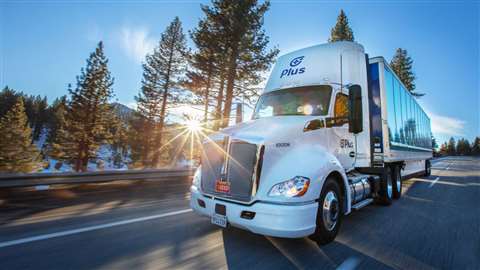Street Smarts: Autonomous? Or ADAS?
09 December 2022
 Attendees of ACT Expo were able to test drive the PlusDrive vehicle control system equipped on a Peterbilt Model 579 Class 8 tractor. (Photo: Plus)
Attendees of ACT Expo were able to test drive the PlusDrive vehicle control system equipped on a Peterbilt Model 579 Class 8 tractor. (Photo: Plus)
At the ACT Expo in Long Beach, Calif., earlier this year, I was fortunate enough to score a test drive with autonomous developer Plus for a quick look at its PlusDrive vehicle control system. Later, Plus invited me to its new headquarters in San Jose, Calif., for a more in-depth test drive around the outskirts of San Francisco in typically chaotic West Coast traffic.
PlusDrive is a retrofit vehicle control system fitted on a Kenworth T680 and a Peterbilt Model 579, which would be my test truck for the drive. The system incorporates an array of sensors cleverly hidden in the rear view mirrors, the front bumper and on the windscreen. It can be fitted on any late model Class 8 tractor.
PlusDrive is a Level 2 autonomous control system, meaning that it requires a human driver behind the wheel. As long as the driver reassures PlusDrive every 15 seconds that he or she is present, the system handles all the heavy lifting involved in driving a fully laden Class 8 tractor-trailer down a busy California freeway.
Driver in control
Engaging PlusDrive is simple: take your foot off the throttle and hit the + or “Plus” (accelerate) button on the steering wheel twice. At once, a confirmation message flashes on the display screen and PlusDrive is in control. But importantly, the driver remains in command of the truck. That’s the critical point and why I believe Level 2 systems like PlusDrive will be the route many fleets take to become acquainted with self-driving trucks.
At this point, PlusDrive is handling every detail required for keeping the truck in the flow of traffic. The system’s sensors and control systems are sharp enough to detect stalled vehicles or even work crews on the side of the road and jog out slightly to avoid the hazard.
Initiating a lane change is as simple as double shifting the turn-signal stalk left or right twice within three seconds. Immediately, PlusDrive begins tracking oncoming vehicles in the selected lane, looking for a safe interval in which to move over. The display screen shows you exactly what the system is doing, with the selected lane flashing red until an opening appears. The lane graphic then immediately turns green and the truck moves over with astonishing confidence – even authority.
Maintaining motion
If traffic slows, PlusDrive immediately decelerates and adopts a new, safe following distance. The system places a premium on maintaining forward motion whenever it can do so safely in the interest of fuel economy. Diesel truck engines burn exponentially higher rates of fuel during the lower parts of the torque curve, so even a little bit of forward motion goes a long way toward mitigating low-end fuel burn. During my drive, even in highly intense, congested merging areas, the truck never once came to a complete stop.
The system also cannot exceed the posted speed limit, though there is a small allowance for higher speeds to deal with passing situations and other variables
So, what does the driver do while PlusDrive is dealing with all the minutia of navigating through traffic? His or her main job is telling the system what they want it do, along with monitoring the environment around the vehicle. This means reminding the system that they are there by putting positive pressure on the steering wheel or tapping the “Plus/Accelerate” button on the steering wheel every 15 seconds. If PlusDrive does not get confirmation that the driver is there, it will flash a “Disengage” warning on the display screen while giving the driver time to reengage. If it doesn’t get a confirmation, the system will begin to safely decelerate and bring the truck to a full stop.
 Jack Roberts is a Tuscaloosa, Ala.-based independent journalist and licensed commercial driver with more than 20 years’ experience covering the North American and global trucking industries.
Jack Roberts is a Tuscaloosa, Ala.-based independent journalist and licensed commercial driver with more than 20 years’ experience covering the North American and global trucking industries.
Intro to autonomy
It all works amazingly well. Toward the end of the drive, my confidence in PlusDrive was so secure that my only physical contact with any control on the truck was my right index finger resting lightly on the “Plus” button with the steering wheel twisting left or right beneath it. I’d tap the button every few seconds to let PlusDrive know I was there. And that was my total contribution to physically controlling an 80,000 lb. truck on the highway.
PlusDrive is not the kind of autonomous system we’ve all been conditioned to expect. It is 100% focused on aiding the driver and it cannot do anything – select a destination, divert around congestion or change lanes – without the driver’s input.
In reality, PlusDrive is more of an Advanced Driver Safety System (ADAS) that takes autonomous control systems to a new, but logical, place for drivers and fleets alike. It’s a practical, driver-focused system that I believe will be a perfect introduction to self-driving trucks as the autonomous age begins to dawn.
STAY CONNECTED




Receive the information you need when you need it through our world-leading magazines, newsletters and daily briefings.
POWER SOURCING GUIDE
The trusted reference and buyer’s guide for 83 years
The original “desktop search engine,” guiding nearly 10,000 users in more than 90 countries it is the primary reference for specifications and details on all the components that go into engine systems.
Visit Now
CONNECT WITH THE TEAM









